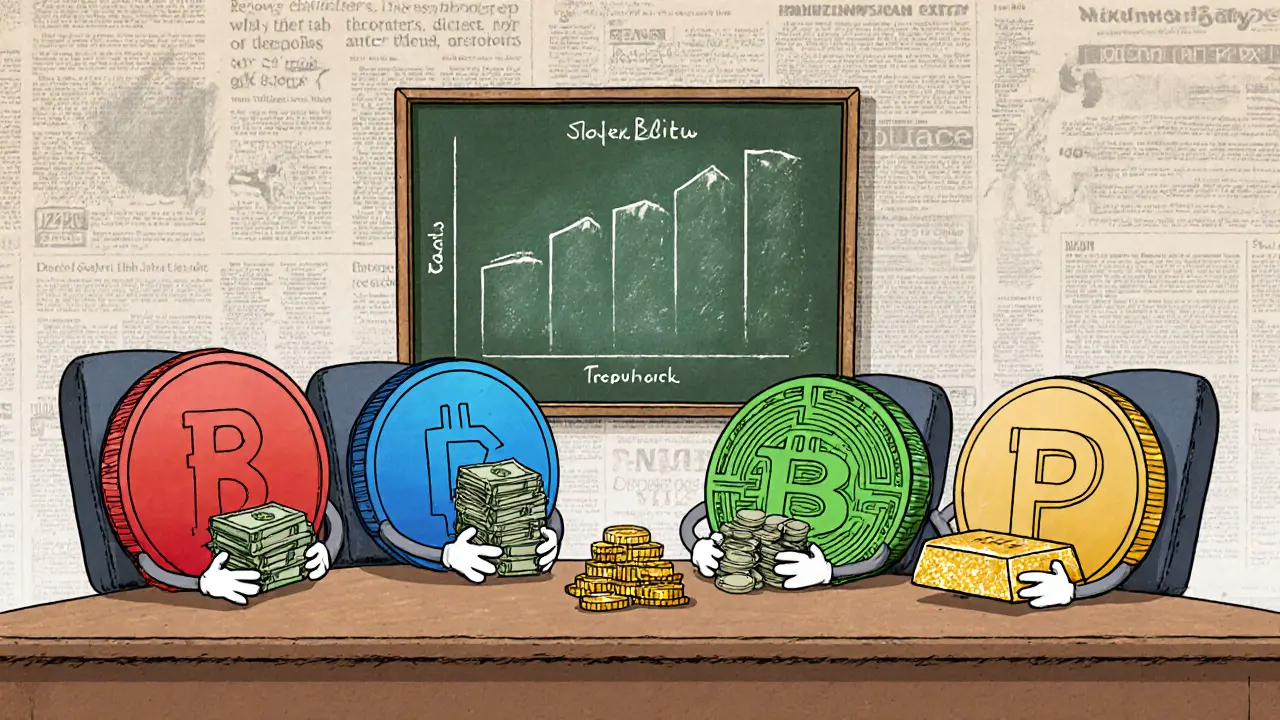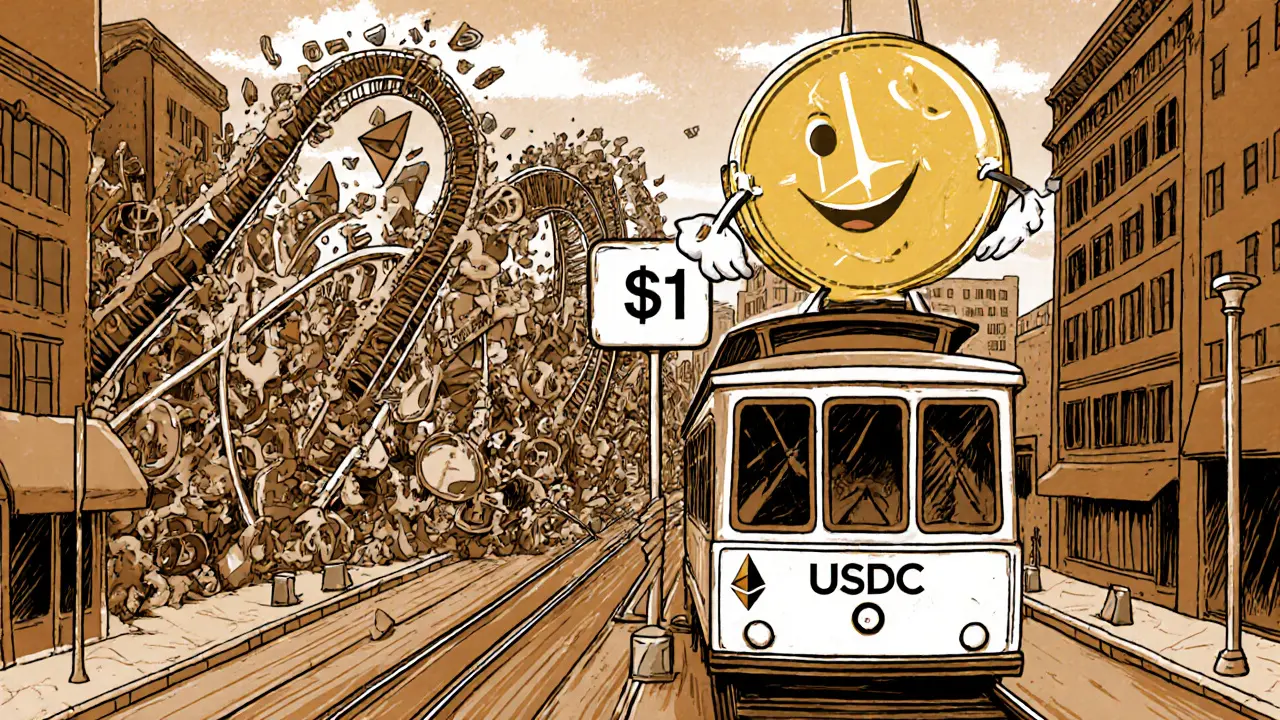Stablecoin Safety Checker
Assess Stablecoin Safety
Learn how to evaluate the safety of stablecoins based on key risk factors. This tool helps you understand the security and stability of your digital assets.
Enter Stablecoin Details
Safety Assessment
Recommendation:
When you hear the term Stablecoins are digital assets designed to keep a steady value by linking to a stable reference like a fiat currency or commodity, the idea of a less‑jumpy crypto world becomes clearer. In short, stablecoins aim to curb the wild price swings that keep many investors on edge.
Why Crypto Volatility Matters
Bitcoin, Ethereum and countless altcoins can double or halve their price in a single day. That kind of roller‑coaster deters merchants, makes payroll in crypto risky, and forces traditional traders to keep a large cash buffer. If you’ve ever tried to use a half‑dollar‑worth Bitcoin to buy a coffee, you know the headache. Stablecoins promise a solution: a crypto‑friendly token that behaves more like cash.
How Stablecoins Keep Their Value
At a high level, a stablecoin stays level by holding something of equal worth in reserve. The reserve can be:
- Cash or short‑term U.S. Treasury bills (the most common backing for fiat‑pegged coins).
- Other cryptocurrencies, but over‑collateralized to cushion price drops.
- Physical commodities like gold.
- Purely algorithmic rules that expand or contract supply.
Whenever the market price drifts away from the peg, smart contracts or custodians buy or sell the reserve assets to pull the price back in line. The process is invisible to most users, but the math and the audits are the foundation of trust.
Four Main Types of Stablecoins
| Type | Peg | Typical Collateral | Example | Risk Profile |
|---|---|---|---|---|
| Fiat‑pegged | 1:1 to a fiat currency (USD, EUR) | Cash & short‑term Treasury bills | USD Coin (USDC) | Low, depends on reserve transparency |
| Crypto‑collateralized | Soft peg to USD, over‑collateralized | Ethereum, other DeFi tokens | DAI | Medium, price of crypto backing can fluctuate |
| Commodity‑backed | 1:1 to a physical metal | Gold or silver stored in vaults | PAX Gold (PAXG) | Low‑to‑Medium, depends on custody of the metal |
| Algorithmic | Supply‑adjusted to maintain price | No collateral, code‑driven incentives | TerraUSD (UST) - collapsed 2022 | High, prone to rapid de‑peg |

Spotlight on the Big Players
The market is dominated by a handful of well‑known coins. Tether (USDT) was the first to claim a 1‑to‑1 USD peg and still boasts the highest circulation. USD Coin (USDC), issued by Circle and Coinbase, emphasizes regular audits and cash reserves held at The Bank of New York Mellon. DAI lives in the MakerDAO ecosystem, letting users lock up Ethereum and other DeFi tokens to mint a dollar‑stable token without a central custodian. Finally, gold‑backed tokens like PAX Gold (PAXG) let investors own a fraction of physical gold while moving it instantly on a blockchain.
Stability Factors: What Keeps the Peg Intact?
Three pillars hold the system together:
- Reserve Quality - Cash and short‑term Treasury bills are the gold standard. When a stablecoin’s reserve includes risky corporate paper or low‑quality crypto, confidence drops fast.
- Transparency - Public attestation reports, third‑party audits, or blockchain‑based proof‑of‑reserves let users verify that the backing really exists.
- Regulatory Clarity - Clear rules about redemption rights, reserve composition, and reporting keep issuers honest. Jurisdictions that demand regular disclosures tend to host more stablecoins that survive market stress.
When any of these pillars wobble, the token can drift from its peg, as we saw with TerraUSD’s abrupt collapse.
Benefits for Users and Businesses
Because stablecoins stay near a constant value, they solve several real‑world pain points:
- Low‑cost, fast cross‑border transfers - Moving USDC from a wallet in Toronto to one in Singapore can settle in minutes for pennies, bypassing SWIFT fees.
- Programmable money - Smart contracts can automatically release funds when conditions are met, enabling escrow, payroll, or DeFi lending without human intervention.
- Access to crypto markets without exposure to wild swings - Traders can park profits in USDT or USDC during a market dip, preserving value while staying on‑chain.
- Better liquidity for decentralized exchanges - Stablecoins act as a reliable base pair, allowing users to trade any token against a dollar‑stable asset.
For a small e‑commerce shop, accepting USDC means the owner doesn’t have to watch Bitcoin price charts to know tomorrow’s revenue. For an individual worker sending remittances, a stablecoin can cut the cost of sending money home by 80% compared with traditional banks.
Risks and Market Concerns
Stablecoins aren’t a magic bullet. The biggest red flags include:
- Run risk - If a large group of holders asks to redeem tokens at once, the issuer must sell reserves quickly, potentially affecting Treasury yields or asset prices.
- Regulatory crackdowns - Sudden legal restrictions on reserve holdings or redemption rights can cause a price drift, as warned by J.P. Morgan analysts.
- Smart‑contract bugs - Crypto‑backed coins rely on code; a flaw could let attackers drain collateral.
- Liquidity mismatches - Some stablecoins hold longer‑term assets for yield, which may not be liquid enough during a panic.
Understanding these risks helps you decide whether a stablecoin fits your risk tolerance.

Current Market Landscape (2025)
By October2025, stablecoins hold roughly $190billion in circulation, dwarfing all other crypto assets combined. The surge began in 2022 when higher Treasury yields made cash‑backed coins attractive for yield‑seeking investors. Today, over 60% of the total stablecoin supply is backed by short‑term U.S. Treasury bills, creating a feedback loop: higher yields draw capital into stablecoins, and stablecoin demand pushes Treasury issuers to offer more short‑term paper.
Regulators in the U.S., EU, and Asia are drafting frameworks that require monthly reserve attestations and clear redemption timelines. In Canada, the recent “Stablecoin Act” mandates that issuers hold reserves in a federally‑inspected custodian, a move that has boosted local confidence.
Institutional adoption is also climbing. Major banks now offer custodial services for USDC and USDT, allowing corporate clients to settle inter‑bank payments on a public ledger. Meanwhile, decentralized finance platforms continue to build lending markets where users earn 5‑8% APY by supplying stablecoins, feeding the cycle of demand.
Future Outlook: Where Do Stablecoins Go Next?
Looking ahead, three trends are likely to shape the space:
- Stronger regulatory harmonization - Global standards on reserve reporting could make stablecoins the preferred bridge between fiat banks and blockchain networks.
- Higher‑yield, low‑risk collateral - Some issuers are experimenting with short‑term municipal bonds or agency securities to boost yields without sacrificing safety.
- Deeper integration with payment rails - APIs that let merchants accept USDC directly into their bank accounts are already live in Europe; similar solutions are rolling out in North America by 2026.
If these developments materialize, stablecoins could become the default settlement layer for everything from grocery purchases to corporate payroll, effectively making crypto volatility a relic of the past.
Key Takeaways
- Stablecoins keep a steady price by holding high‑quality reserves, most often cash and short‑term U.S. Treasury bills.
- Four main families exist - fiat‑pegged, crypto‑collateralized, commodity‑backed, and algorithmic - each with its own risk profile.
- Major players like USDT, USDC, DAI, and PAXG dominate the market, and their transparency levels drive user confidence.
- Benefits include cheap cross‑border transfers, programmable money, and reduced exposure to crypto swings.
- Risks such as run scenarios, regulatory changes, and smart‑contract bugs mean users should stay informed and choose reputable issuers.
Frequently Asked Questions
How does a fiat‑pegged stablecoin stay $1?
The issuer holds an equivalent amount of cash or short‑term U.S. Treasury bills in a bank. When demand pushes the price above $1, the issuer sells some of the reserve for the token, pulling the price down. If the price falls below $1, new tokens are minted and the reserve is bought back, pushing the price up.
Can I lose money if a stablecoin fails?
Yes, but the loss size depends on the coin’s backing. A well‑audited fiat‑backed coin like USDC typically returns the full amount, while algorithmic tokens without collateral can become worthless, as seen with TerraUSD.
Are stablecoins regulated?
Regulation is evolving. In the U.S., the Treasury and SEC are drafting rules that would require regular reserve attestations. The EU’s MiCA framework already enforces transparency, and Canada’s Stablecoin Act mandates custodial oversight.
How do stablecoins compare to traditional bank transfers?
Bank wires can take 1‑3days and cost $15‑$30 per transaction. Stablecoin transfers settle in minutes on a public blockchain and usually cost a few cents, making them far cheaper and faster for cross‑border payments.
What should I look for before using a stablecoin?
Check the reserve composition (cash vs. risky assets), verify audit frequency, see if the issuer is regulated in your jurisdiction, and assess the token’s market depth. A transparent, well‑regulated coin with daily attestations is typically the safest choice.

